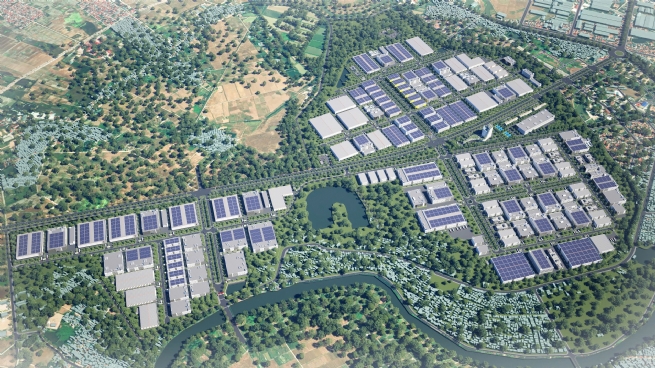On July 1, 2025, the three provinces of Phu Tho, Vinh Phuc, and Hoa Binh officially merged, marking their appearance as a new entity on the national administrative map. More than a redrawing of boundaries, the new Phu Tho embodies a bold vision: to serve as a growth pole and driving force for the Northern Midlands and Mountainous Region, while also ushering in a new stage of development for the northern industrial real estate market, particularly in the strategic gateway area to Hanoi.

CNCTech breaks ground on Nam Binh Xuyen Green Park, Phu Tho Province, September 19, 2025
Encouraging numbers
Before the merger, each province had distinct advantages but uneven levels of development. Vinh Phuc excelled in industry and construction, with a GRDP of more than VND173.14 trillion in 2024, ranking 13th nationwide; Phu Tho recorded VND107.3 trillion; and Hoa Binh reached VND72.18 trillion. GRDP per capita stood at VND141.3 million in Vinh Phuc, about VND70.7 million in Phu Tho, and nearly VND81 million in Hoa Binh. Although each province maintained relatively high growth rates of above 9 to 10%, they remained separate entities without the combined strength to create a significant regional breakthrough.
The merger has transformed the situation. In only two months, the new Phu Tho has shown that it is not a simple combination but a source of strong synergy. In the first six months, the province’s GRDP reached VND186.4 trillion, rising 10.09% year-on-year and placing it among the six fastest-growing localities nationwide. Industry and construction made up 46.58% of GRDP with growth of 15.32%, services expanded 8.2%, and agriculture forestry and fisheries stayed stable. The economic structure is being reshaped toward industrialization and modernization, confirming the province’s role as an industrial hub of the region.
Investment capital is flowing in strongly. In the first six months, the province attracted nearly US$469 million in foreign direct investment (FDI); by the end of July, this had risen to US$651.7 million, including 35 new projects and 45 expansion projects. Domestic direct investment (DDI) exceeded VND43 trillion, with Hoa Binh alone accounting for VND38.006 trillion. Newly established enterprises nearly doubled, with 2,976 companies and total registered capital of more than VND26 trillion; nearly 1,000 businesses resumed operations. With over 4 million people and an area of more than 9,300 square kilometers, the domestic market has become a focal point for investment.
Not only industry, but trade and services are also booming. Total retail sales of goods and service revenue in the first six months surpassed VND94 trillion, up 14.47% year-on-year. Import-export turnover reached US$34.4 billion, up 21.7%. The Index of Industrial Production (IIP) jumped 25.73% in the first seven months - far exceeding the national average. These figures confirm new momentum, clearly different from the pre-merger period.

Perspective of Nam Binh Xuyen Green Park
Investment orientation
Leaders of Phu Tho province emphasized that the long-term vision for the province is not simply administrative reorganization but the pursuit of becoming an industrial, service, logistics, and tourism hub for both the Northern Midlands and Mountainous Region and the entire country. The difference before and after July 1 is clear. In the past, investment promotion and tourism marketing efforts were fragmented and overlapped. Today, the new province is carrying out larger-scale and more coordinated programs. Key transport routes such as the Noi Bai-Lao Cai Expressway, the Hoa Lac-Hoa Binh Expressway, and the Vinh Yen-Viet Tri route now link the former provinces while also acting as vital lifelines for a unified development space.
Notably, the industrial zone system is expanding strongly to 58 zones covering more than 14,000 hectares, with an average occupancy rate of 44.3%. Across the province, there are 818 projects in industrial zones, including 507 FDI projects with total capital of over US$9.7 billion, creating jobs for nearly 210,000 workers. High-tech industries, electronics, and precision engineering are gradually becoming the province’s hallmark.
The merger has also brought fresh vitality to culture and tourism. The heritage of the Hung Kings’ ancestral land combines with the Muong identity of Hoa Binh and the modern industrial character of Vinh Phuc to create a dynamic mosaic. From the Hung Kings’ Temple Festival, the Tay Thien spiritual tourism and the Mai Chau community tourism to resorts and high-tech parks, all elements are working together to shape a unified tourism product directed toward sustainable development.
However, the challenges are considerable. The new administration must balance regional interests, ensuring fairness through infrastructure, education, and workforce support in disadvantaged areas. Rapid industrialization also demands strict commitment to green, sustainable development.
Yet, with strong political will, many factors suggest Phu Tho is on the right track. Administrative reform is being accelerated, investment procedures streamlined, public investment disbursement is rising quickly, and the one-stop interlinked mechanism is becoming more effective. Investment promotion conferences are larger in scale, attracting interest from many domestic and foreign corporations. Public confidence is also reinforced as people witness tangible changes in socio-economic life.
Since July 1, the new Phu Tho has embarked on a new journey, where growth figures are not only achievements but also a promise of a brighter future. With an economic scale exceeding VND318 trillion, double-digit GRDP growth, dynamic investment flows, and thousands of new enterprises, the new Phu Tho has affirmed its role as a growth engine and a springboard for the Northern Midlands and Mountainous Region.
By Le Hien, Vietnam Business Forum